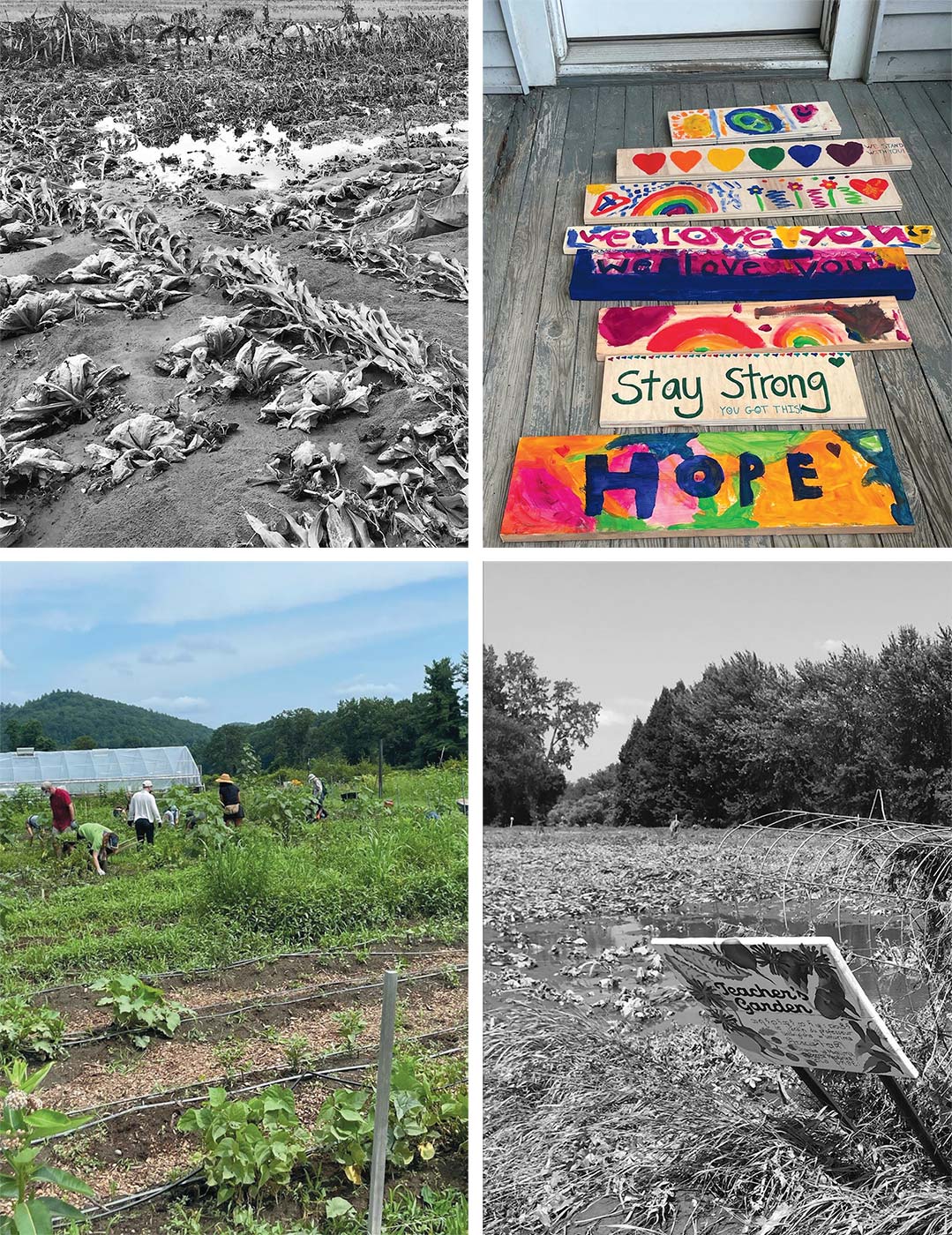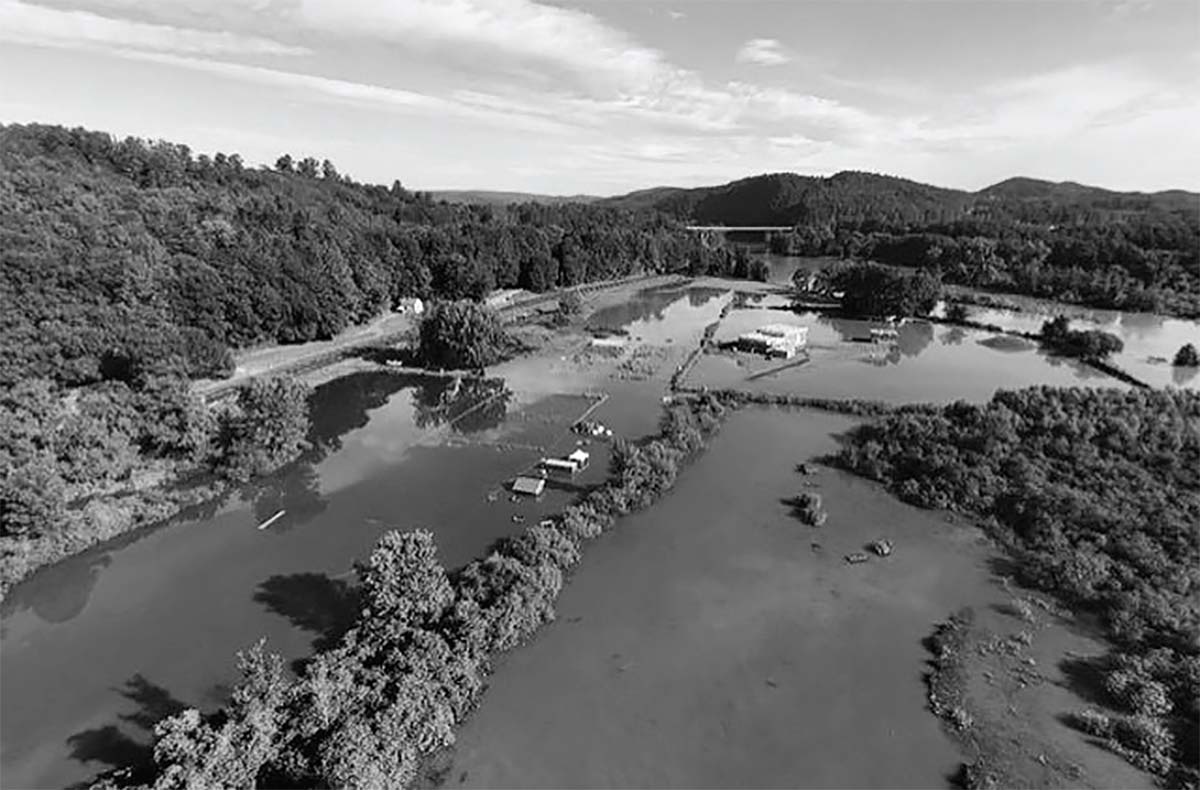Planting Seeds of Recovery and Resilience for Vermont Farms

(top right) Photo courtesy Vermont Community Food Project; (all others) Photo courtesy Aalv For New Farms For New Americans
“It’s one thing to know it’s all gone. It’s another thing to walk the land you know as well as the back of your hand and witness the destruction.” –Alisha Laramee, Program Manager, New Farms for New Americans (NFNA)
“It’s one thing to know it’s all gone,” said Alisha Laramee, program manager at New Farms for New Americans (NFNA). “It’s another thing to walk the land you know as well as the back of your hand and witness the destruction.”
As the rain that would cause catastrophic flooding around Vermont began to fall on July 9 and 10, 2023, Alisha called the 100 farming households around Vermont that comprise New Farms for New Americans, a gardening and agriculture program for refugees and immigrants, and urged them to harvest whatever they could. “The river is going to get very big,” she said in the most direct terms possible to ensure that the message could be translated into six languages. “Move your equipment to high ground.”
Walking the 5 acres of land NFNA leases from the Winooski Valley Park District and the 5 acres leased from the Intervale Center later that week, all Alisha could think about was the loss—months’ worth of food, culturally relevant crops that can’t be purchased locally, seeds for next season’s harvest, and the “food security, belonging, and purpose” that come with farming in Vermont.
According to the latest data available in the Vermont Agency of Agriculture, Food & Markets interim survey, more than 200 farms and 27,000 acres of Vermont crops were devastated by the flooding in July, which caused more than $16 million in damage for agricultural producers, many of whom do not have crop insurance. With harvest season underway, it remains to be seen if the crops that did survive—particularly corn and hay used for animal feed—will be salvageable. Heavy silt deposits and chemicals impacted much of it as water moved across the land.
Vermonters Helping Vermonters
While state and federal agencies have committed significant resources to farm recovery, that aid has been slow to reach farm families. During a tour of Mazza’s Farm in Essex Junction in July, Gov. Phil Scott emphasized the need for private donations to help Vermont farms recover. “We are going to have to be creative; we are going to have to reach into every pot in order to get through this,” he said in an interview with WCAX-TV. One of those pots is the VT Flood Response & Recovery Fund 2023, established by the
Vermont Community Foundation (VCF) on July 11, even as rivers continued to rise. “One of the defining truths about Vermont is that Vermonters look out for one another,” said Dan Smith, president and CEO of the Vermont Community Foundation, when announcing the fund. “We saw it during the pandemic; we saw it during Tropical Storm Irene. As we watch the updates come in from across the state today, we see it again.”
Within 10 days, the fund had raised $2.5 million and began distributing money. By the end of July, the Community Foundation had more than a half-million dollars at work in the community.
By late August, the VT Flood Response & Recovery Fund had taken in more than $6.1 million in gifts and commitments and distributed more than $2 million in grants to more than 60 towns across Vermont.
Supporting farmers, who were already struggling after the late spring frost, is a core priority of the fund, which also identifies housing, small businesses, and nonprofit organizations as critical areas of need.
Since the flooding began, the Community Foundation has issued multiple rounds of grants to nonprofits helping farmers recover from their losses, including $40,000 to the Center for an Agricultural Economy (CAE), $30,000 to the Northeast Organic Farming Association of Vermont (NOFA-VT), $25,000 to the Intervale Center, $20,000 to the Community Food Project, $20,000 to RELEAF, $10,000 to the Association of Africans Living in Vermont, and $10,000 to the Vermont Garden Network. A full list of grantees can be found at vtfloodresponse.org/grantees.
“I know that New Farms for New Americans can and will rebuild and recover,” said Alisha, “but what about the farmers? How do they recoup their financial losses? And then the Community Foundation wrote this most glorious email. “No additional work at a time of triage and crisis. Just a question: where do we mail the check?”
In August, the Community Foundation announced the Farm Disaster Relief Grant Program, committing up to $1 million of the fund to direct-to-farms grants in amounts up to $10,000. The grants will help farmers replace seeds, livestock, equipment, and supplies; supplement lost income; repair their farms; and cover flood-related expenses. This direct-to-farms grant program is made possible by many organizations and individuals who contributed generously to the VT Flood Response & Recovery Fund 2023, including many VCF fundholders who used their donor advised funds to make grants through the Community Foundation.
In August, the Community Foundation announced the Farm Disaster Relief Grant Program, committing up to $1 million of the fund to direct-to-farms grants in amounts up to $10,000. The grants will help farmers replace seeds, livestock, equipment, and supplies; supplement lost income; repair their farms; and cover flood-related expenses.

An aerial view of farms within the Intervale, overwhelmed by the Winooski River. Photo: Fhar Miess.
A Long Road Ahead for Farmers
Currently, in the first two phases of a three-part grant-making strategy, the Community Foundation remains focused on phase one: meeting people’s basic needs in the aftermath of the flooding. In coordination with FEMA and the Red Cross, multiple waves of fast-moving grants have been directed toward ensuring people are fed, clothed, and sheltered and that farms are receiving immediate support. At the same time, many affected Vermonters are moving through the process of applying for aid through state and federal organizations.
The Community Foundation is also planning long-term support. Phase two of the Flood Response & Recovery strategy directs grants toward building back Vermont communities. For farmers, this means helping them navigate the federal funding process, providing resources to growers whose crops and products are eligible for less federal support, and ensuring that all types of farms and farmers have access to resources.
The third and final phase will focus on watershed management to increase community resilience and to help Vermont adapt to, and prepare for, changes in climate and weather patterns. Lu Neuse, executive director of the Community Food Project in Brattleboro, is already thinking about how to weather the next event. “We are working to ensure a more resilient future for our farms, gardens, and programs by moving out of the flood zone to another field on the Retreat Farm property,” she said.
“The generous support of the Community Foundation will help us lay the groundwork to rebuild the beautiful gardens and vibrant, diverse community that had started to grow in them.”
In Times of Emergency, What We Have Is Community
“Shortly after the flood, I heard Grace Oedel, executive director of NOFA-VT, say that in times of emergency, what we have is our community,” said Lu, “and this emergency has made it very clear how generous, kind, and engaged our community truly is.”
Numerous agriculture-related brands in Vermont, including American Flatbread, Ben & Jerry’s, Blake Hill Preserves, Dedalus, Stowe Cider, Allagash Brewing, Foam Brewers, Mansfield Maple, Vermont Creamery, Lawson’s Finest Liquids, Harpoon Brewery, Lake Champlain Chocolates, and Woodchuck Cider stepped up to support fundraising efforts for farms.
“We continue to see incredible generosity from the community both within and beyond Vermont,” said Dan Smith at the Vermont Community Foundation. “Businesses donated generously, matched employee contributions, and earmarked sales proceeds. Our donor advised fundholders answered the call, many making supplemental direct grants across the state. Artists created special pieces. Others used their networks to encourage donations. Everywhere, folks used their talents, their products, and their resources to raise money for Vermonters.”
On September 7, the Flynn Theatre in Burlington hosted Hug Your Farmer: Hard Rain, with presenting partner Select Design; an all-star lineup of Vermont performers celebrated the music of Bob Dylan led by local musician Bob Wagner. Hug Your Farmer began in 2010 to raise money for Pete’s Greens, whose barn had been destroyed by a fire, and has since played five benefit shows raising more than $120,000 for Vermont farmers. All of this year’s proceeds, 100 percent, will go to the VT Flood Response & Recovery Fund at the VCF, up to $100,000 of which will be matched dollar for dollar by a generous VCF donor.
“We are devastated by the destruction of our little farm and by the grief and loss suffered by our community gardeners, particularly the recent refugees who have already lost so much,” said Lu Neuse. “But we are also comforted and humbled by the support of so many people in our community.”
“The glimmer of light is the outpouring of love from the Vermont community,” agreed Alisha Laramee.
About the Vermont Community Foundation
While most visible during times like these—when unforeseen emergencies require urgent action—the Vermont Community Foundation was founded to help Vermonters create permanent charitable funds to keep Vermont strong and vital as it meets the challenges of the future. Today, its funds and programs provide more than $60 million a year in grants in Vermont and beyond.




